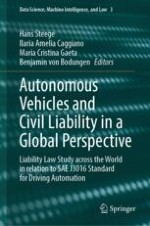2024 | OriginalPaper | Buchkapitel
Civil Liability for Motor Vehicle Crashes in the United States: From Conventional Vehicles to Autonomous Vehicles
verfasst von : Mark A. Geistfeld
Erschienen in: Autonomous Vehicles and Civil Liability in a Global Perspective
Aktivieren Sie unsere intelligente Suche, um passende Fachinhalte oder Patente zu finden.
Wählen Sie Textabschnitte aus um mit Künstlicher Intelligenz passenden Patente zu finden. powered by
Markieren Sie Textabschnitte, um KI-gestützt weitere passende Inhalte zu finden. powered by
